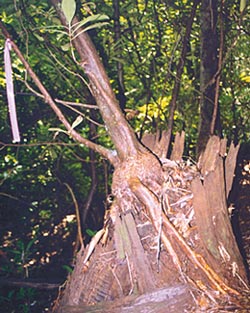
This Article From Issue
January-February 2003
Volume 91, Number 1
DOI: 10.1511/2003.11.0
If a tree once felled other trees in the woods, but was no longer around to be studied, would it make for good research?
The American chestnut was once the most common canopy tree in the deciduous forests of the eastern United States. It shaded areas from New England to Georgia until the fungus Cryphonectria parasitica wiped out the species in the infamous blight of the early 20th century. The fungus continues to kill chestnuts before they can mature.
The void left by the chestnut's demise is now filled with competing species. Considerable research has gone into understanding what happened to the American chestnut. But some scientists remain interested in getting to the root not of its demise, but rather of the centuries of dominance enjoyed by the massive, fragrant and economically important tree. David B. Vandermast, a biology graduate student at the University of North Carolina at Chapel Hill, and his colleagues recently posited that Castanea dentata may have been engaged in the chemically charged competition known as allelopathy.
An allelopathic plant releases potentially toxic substances into the environment through its roots, its leaves or processes such as evaporation. Black walnut, sycamore and sassafras trees are just a few known allelopaths that limit the germination of competitors. It's likely that the list will soon branch out to include the chestnut.
Vandermast's study, described in the July 15 issue of Forest Ecology and Management, found that extracts from the American chestnut leaf significantly limited the germination of lettuce, eastern hemlock and unstratified rhododendron seeds. The tree's rapid growth, dense foliage and slowly decaying leaf litter may have allowed regular rainfalls to douse competitors with leachate that defended against encroachment. The blight not only ended the chestnut's dominance but also, as Vandermast notes, contributed to changes in vegetative composition—and may have even put chestnuts on the allelopathic receiving end.
Chestnut sprouts can reach five inches in diameter before the fungus cuts them down, according to Vandermast. The sprouts are still prolific, but anecdotal evidence suggests that something is limiting their growth.

David Vandermast
"It's possible to find sprouts and dead trees in Southern Appalachia," Vandermast says. "In areas where there are dense rhododendron, there are old chestnut stumps, but no sprouts." The same holds true in areas where hemlock grows around chestnut stumps. "The hemlock didn't grow alongside the chestnut [in its pre-blight days], even though it's shade-tolerant," he says. But now, where there's hemlock, there's a noticeable absence of chestnut sprouts.
The publication of the allelopathy study hints at the chemical warfare waged throughout the forests. Coincidentally, it also commemorates the 25th anniversary of David E. Flora's 1977 master's thesis, "The American chestnut as an allelopath," completed at the University of Tennessee, Knoxville. Flora, under the supervision of Frank W. Woods (two men whose names suggest they were destined for careers in forestry), showed that the American chestnut hindered the germination of radish seeds.
Flora also demonstrated in his discussion section how long it can take for ideas to germinate into completed research when he noted: "Tests of germination of native seeds ... might reveal whether toxins are released from decaying leaves."
Vandermast says he learned of Flora's work after submitting his own manuscript for publication. After reviewing it, he was relieved to find that he hadn't duplicated someone else's work. "I was glad to see that his results compared favorably with mine, and it is nice that he suggested that someone should do what I did!"—Frank Diller
American Scientist Comments and Discussion
To discuss our articles or comment on them, please share them and tag American Scientist on social media platforms. Here are links to our profiles on Twitter, Facebook, and LinkedIn.
If we re-share your post, we will moderate comments/discussion following our comments policy.